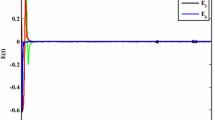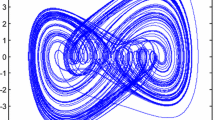Abstract
In this paper, a novel adaptive interval type-2 fuzzy active sliding mode control (AIT2FASMC) approach is proposed for synchronization of fractional-order hyper-chaotic systems. The synchronization is achieved in front of uncertainties facing the fuzzy logic controller (FLC) in fractional–order hyper-chaotic systems such as uncertainties in control outputs, uncertainties in inputs to the fuzzy logic controller, and linguistic uncertainties. Two fractional-order hyper-chaotic systems can be synchronized based on Lyapunov stability theorem by using direct AIT2FASMC approach. Also, the proposed method reduces the chattering phenomena in the control signal, significantly. This novel fractional-order sliding mode controller is proposed for robust stabilization/synchronization problem of a class of fractional-order hyper-chaotic systems in the presence of external noise. Type-2 fuzzy active sliding mode control \(\left( {FASMC}\right) \) have the ability to overcome the limitations of type-1 FASMC when system is corrupted by high levels of uncertainty. Finally, the proposed approach is applied to two identical and non-identical fractional-order hyper-chaotic systems when the slave system is perturbed by external noise. Simulation results show applicability and feasibility of the proposed finite-time control strategy.











Similar content being viewed by others
References
Ross B (1974) Fractional calculus and its applications. Lecture Notes Math. Springer, Berlin
Ross B (1975) Fractional calculus and its applications. Lecture Notes Math 457:37–79
Petras I (2008) A note on the fractional-order Chua’s system. Chaos Solitons Fract 38:140–147
Lu JG, Chen G (2006) A note on the fractional-order Chen system. Chaos Solitons Fract 27:685–688
Yanchuk S, Maistrenko Y, Mosekilde E (2003) Synchronization of time-continuous chaotic oscillators. Chaos: an interdisciplinary. J Nonlinear Sci 13:388–400
Baht SP, Bernstein DS (2000) Finite-time stability of continuous autonomous systems. SIAM J Control Optim 38:751–766
Orlov Y (2005) Finite-time stability and robust control synthesis of uncertain switched systems. SIAM J Control Optim 43:1253–1271
Hugues-Salas O, Banks SP (2008) Optimal control of chaos in nonlinear driven oscillators via linear time-varying approximations. Int J Bifurcation Chaos 18:3355–3374
Hua C, Guan X (2004) Adaptive control for chaotic systems. Chaos Solitons Fract 22:55–60
Chen B, Liu X, Tong S (2007) Adaptive fuzzy approach to control unified chaotic systems. Chaos Solitons Fract 34:1180–1187
Chang JF, Hung ML, Yang YS, Liao TL, Yan JJ (2008) Controlling chaos of the family of Rössler systems using sliding mode control. Chaos Solitons Fract 37:609–622
Mohadeszadeh M, Delavari H (2015) Synchronization of fractional-order hyper-chaotic systems based on a new adaptive sliding mode control. Int J Dynam Control. doi:10.1007/s40435-015-0177-y
Nagarale RM, Patre BM (2014) Exponential function based fuzzy sliding mode control of uncertain nonlinear systems. Int J Dynam Control. doi:10.1007/s40435-014-0117-2
Castillo O, Melin P (2008) Intelligent systems with interval type-2 fuzzy logic. Inform Control 4:771–784
Li C, Yi J, Zhao D (2009) Design of interval type-2 fuzzy logic system using sampled data and prior knowledge. ICIC Express Lett 3:695–700
Zadeh LA (1975) The concept of a linguistic variable and its application to approximate reasoning. Inform Sci 9:43–80
Castillo O, Melin P, Tsvetkov RT, Atanassov K (2015) Short remark on fuzzy sets, interval type-2 fuzzy sets, general type-2 fuzzy sets and intuitionistic fuzzy sets. Intell Syst 322:183–190
Zadeh LA (1975) The concept of a linguistic variable and its application to approximate reasoning-I. Inform Sci 8:199–249
Gomide Fernando AC (2003) Uncertain rule-based fuzzy logic systems introduction and new directions. Fuzzy Sets Syst 133:133–135
Wagenknecht M, Hartmann K (1988) Application of fuzzy sets of type-2 to the solution of fuzzy equations systems. Fuzzy Sets Syst 25:183–190
Castro JR, Castillo O, Melin P, Rodriguez-Diaz A (2009) A hybrid learning algorithm for a class of interval type-2 fuzzy neural networks. Inform Sci 179:2175–2193
Dereli T, Baykasoglu A, Altun K, Durmusoglu A, Turksen IB (2011) Industrial applications of type-2 fuzzy sets and systems. Comput Ind 62:125–137
Castillo O, Aguilar LT, Cazarez-Castro NR, Cardenas S (2008) Systematic design of a stable type-2 fuzzy logic controller. Appl Soft Comput 8:1274–1279
Hagras H (2004) Hierarchical type-2 fuzzy logic control architecture for autonomous mobile robots. Fuzzy Syst 12:524–539
Hsiao M, Li THS, Lee JZ, Chao CH, Tsai SH (2008) Design of interval type-2 fuzzy sliding-mode controller. Inform Sci 178:1686–1716
Mendoza O, Melin P, Castillo O (2009) Interval type-2 fuzzy logic and modular neural networks for face recognition applications. Appl Soft Comput 9:1377–1387
Deng WH, Li CP (2005) Chaos synchronization of the fractional Lü system. Phys A 353:61–72
Chen G, Ueta T (1999) Yet another chaotic attractor. Int J Bifurcation Chaos 9:1465–1466
Li CP, Chen G (2003) A note on hopf bifurcation in Chen’s system. Int J Bifurcation Chaos 6:1609–1615
Deng WH, Li CP (2005) Synchronization of chaotic fractional chen system. J Phys Soc Jpn 74:1645–1648
Utkin VI (1977) Variable structure systems with sliding mode. IEEE Trans Autom Control 22:212–222
Slotine JJE (1984) Sliding controller design for non-linear systems. Int J Control 40:421–434
Yu X, Kaynak O (2009) Sliding-mode control with soft computing. IEEE Trans Ind Electron 56:3275–3285
Podlubny I (1999) Fractional differential equations. Academic Press, New York
Uchaikin V (2013) Fractional derivatives for physicists and engineers. Nonlinear physical science. Springer, Berlin
Ortigueira M (2011) Fractional calculus for scientists and engineers. Lecture notes in electrical engineering. Springer, Netherlands
Kilbas AA, Srivastava HM, Trujillo JJ (2006) Theory and applications of fractional differential equations. Elsevier Science Inc, New York
Baleanu D, Machado JAT, Luo ACJ (2012) Fractional dynamics and control. Springer, New York
Caponetto R et al (2010) Fractional-order systems: modeling and control applications. World Scientific, Singapore
Diethelm K, Ford NJ, Freed AD (2004) Detailed error analysis for a fractional Adams method. Numer Algorithms 36:31–52
Ziegler JG, Nichols NB (1942) Optimum settings for automatic controllers. Trans ASME 64:759–768
Mendel JM (2004) Computing derivatives in interval type-2 fuzzy logic systems. Fuzzy Syst 12:84–98
Monje A, Chen YQ, Vinagre BM et al (2010) Fractional-order systems and controls. Springer, New York
Ortigueira M, Machado JA (2015) What is a fractional derivative? J Comput Phys 293:4–13
Aguila-Camacho N, Duarte-Mermoud MA, Gallegos JA (2014) Lyapunov functions for fractional-order systems. Commun Nonlinear Sci Numer Simul 19:2951–2957
Matouka AE, Elsadany AA (2014) Achieving synchronization between the fractional-order hyper-chaotic novel and chen systems via a new nonlinear control technique. Appl Math Comput 29:30–35
Author information
Authors and Affiliations
Corresponding author
Rights and permissions
About this article
Cite this article
Mohadeszadeh, M., Delavari, H. Synchronization of uncertain fractional-order hyper-chaotic systems via a novel adaptive interval type-2 fuzzy active sliding mode controller. Int. J. Dynam. Control 5, 135–144 (2017). https://doi.org/10.1007/s40435-015-0207-9
Received:
Revised:
Accepted:
Published:
Issue Date:
DOI: https://doi.org/10.1007/s40435-015-0207-9




